12 Best Social Media Analytics Tools: Top Platforms Compared
Tracking performance shouldn’t feel like detective work. The right tool pulls every post, click, and comment into one clean story: what worked, what didn’t, and what to do next.
This is your ultimate guide to the best social media analytics tools: we compare and analyze 19 platforms that actually make sense of the mess.

Jan 02 2026●12 min read
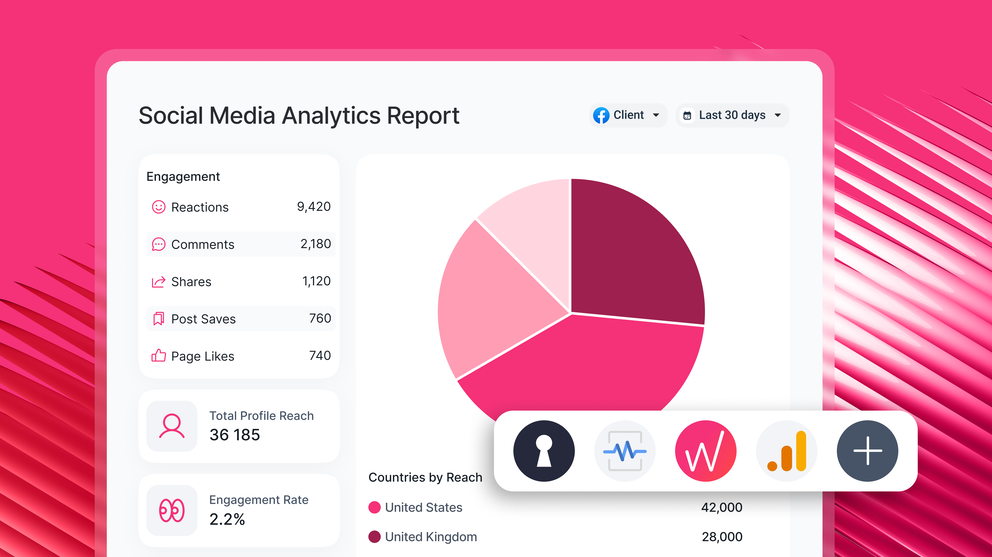
The best social media analytics tools don’t drown you in data; they make sense of it.
They pull paid and organic results into one view, explain what the numbers actually mean, and hand you back your Sunday afternoons by automating the busywork.
But before choosing your next platform, make sure it checks these four boxes (every tool in this list was evaluated against them):
Feature | Qualifying Question |
| Cross-platform data integration | Can I see organic and paid performance from all my social channels in one view? |
| Ease of use and quick setup | Can my team get started without technical help? |
| Customizable dashboards and audience insights | Can I easily tailor dashboards for each client or advertising goal? |
| Sharing and automation | Can I automate delivery so stakeholders get fresh data without lifting a finger? |
12 Best Social Media Analytics Tools in 2026
Here's a summary of the top social media analytics tools we'll be reviewing:
- Whatagraph
- Metrics Watch
- Keyhole
- Google Analytics 4 (GA4)
- Sprout Social
- Buffer
- Hootsuite
- Brandwatch
- Rival IQ
- Zoho Social
- Mentionlytics
- BuzzSumo
1. Whatagraph
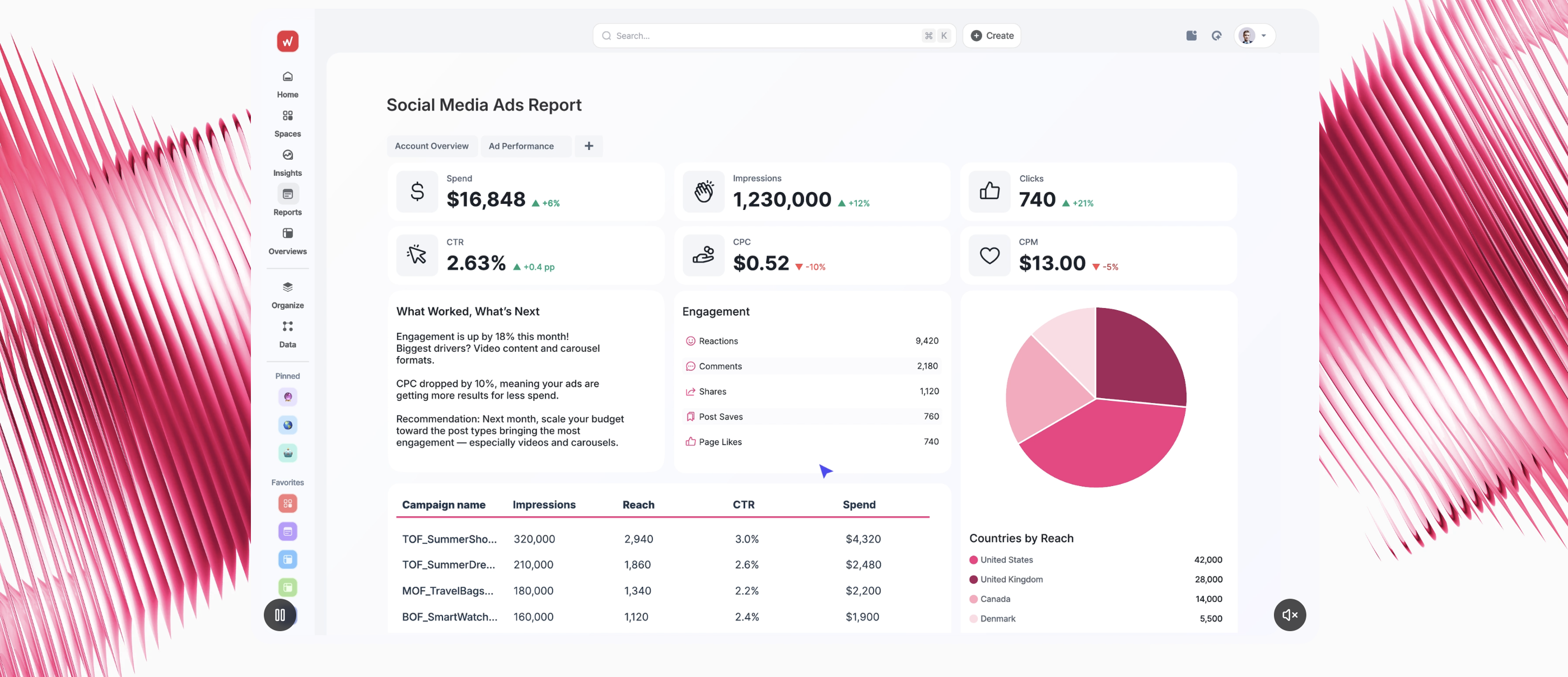
Whatagraph is (quite literally) the easiest marketing intelligence and social media analytics platform in the market right now, thanks to powerful AI features that builds, styles, and analyzes reports for you.
Our core philosophy is that we are built for marketers, not data teams. And as such, you can get a perfectly white-labeled social media report in seconds—without having to deal with broken connections, clunky dashboards, or slow load times.
In fact, agencies like Maatwerk Online are already saving 100 hours a month on reporting thanks to Whatagraph. Lars Maat, Co-Founder of the agency says:
Whatagraph saves time and energy for our marketing specialists. And the hours we’re saving is just pure profit. We now have the time to focus on more strategic things that help both our agency and our clients grow.
Read the full case study here.
Here’s how Whatagraph stacks up across the must-have features:
Can I see organic and paid performance from all my social channels in one view?
Yes. You can connect both organic and paid sources through native, stable integrations that our Product Engineers maintain and monitor in-house.
- Go to Sources > + Connect new source.
- Connect: Facebook Pages, Instagram Business, TikTok, LinkedIn Pages, YouTube (organic).
- Connect: Meta Ads (Facebook/Instagram Ads), TikTok Ads, LinkedIn Ads (paid).
Whatagraph also allows you to blend data from different sources, unify names and dimensions, and create new metrics through simple no-code workflows.
For example, you can blend all your organic data (Facebook + Instagram + TikTok) to see a single, holistic view of your overall organic social performance, or do the same for all your paid channels.
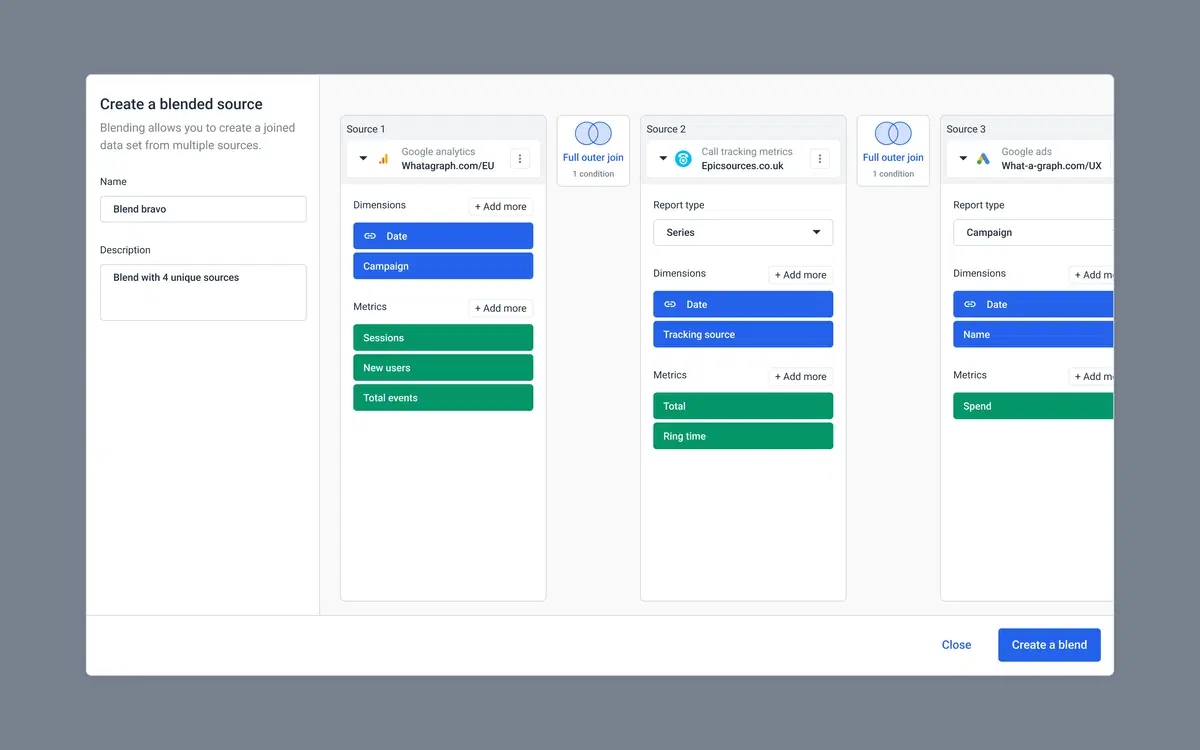
In fact, this unified dashboard approach is what led Tanja Keglić, Performance Marketing Manager at Achtzehn Grad, to become a Whatagraph-convert:
The biggest reason we chose Whatagraph was because of its holistic approach to reporting. We can blend data from different channels and see in one view what's the performance and what needs to be changed.
Read the full case study here.
Quick tips:
- Don’t blend organic and paid into one dataset. Keep them separate and compare at the summary level.
- Save the custom metrics, dimensions, and blends as “Team Template” so everyone on your team can reuse them easily the next time.
Can my team build reports easily without technical help?
The short answer: yes.
The long answer: with Whatagraph IQ, you can literally just type in a prompt (e.g., "Create an Instagram report showing engagement rate and follower growth for the last 30 days") and we'll build a complete report for you, with the exact widgets, charts, and tables you need.
No manual work or complex technical setups needed.
Just connect your data sources and give specific prompts. We handle the rest. And this entire process, from start to finish, only takes minutes.
Try it out for yourself here:
If you’d rather have full control over the design and layout, start from a blank canvas and drag-and-drop pre-made widgets onto it. Or choose a report template from our pre-made library and customize it as needed.
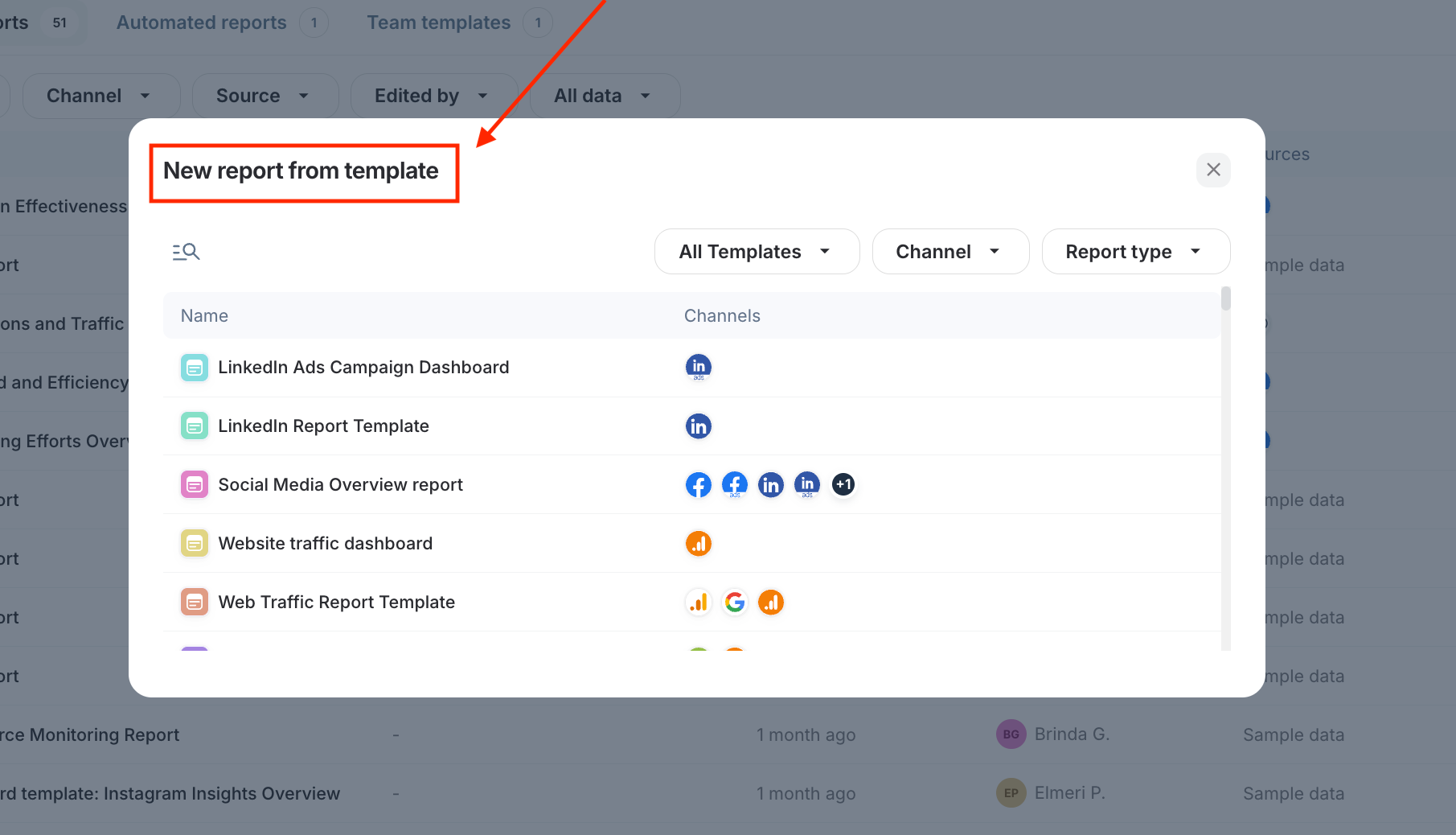
Tired of writing performance summaries and action items manually? Whatagraph IQ Summary will write it for you based on the data on your entire report or a specific tab.
Just drop a text widget onto your report canvas and choose:
- The content type – Summary, Recommendations, Wins, Issues, or Custom Prompt
- The language – available in 18 languages

Need an answer fast? IQ Chat allows you to ask a natural language question about the data within your report and get an instant, actionable answer.
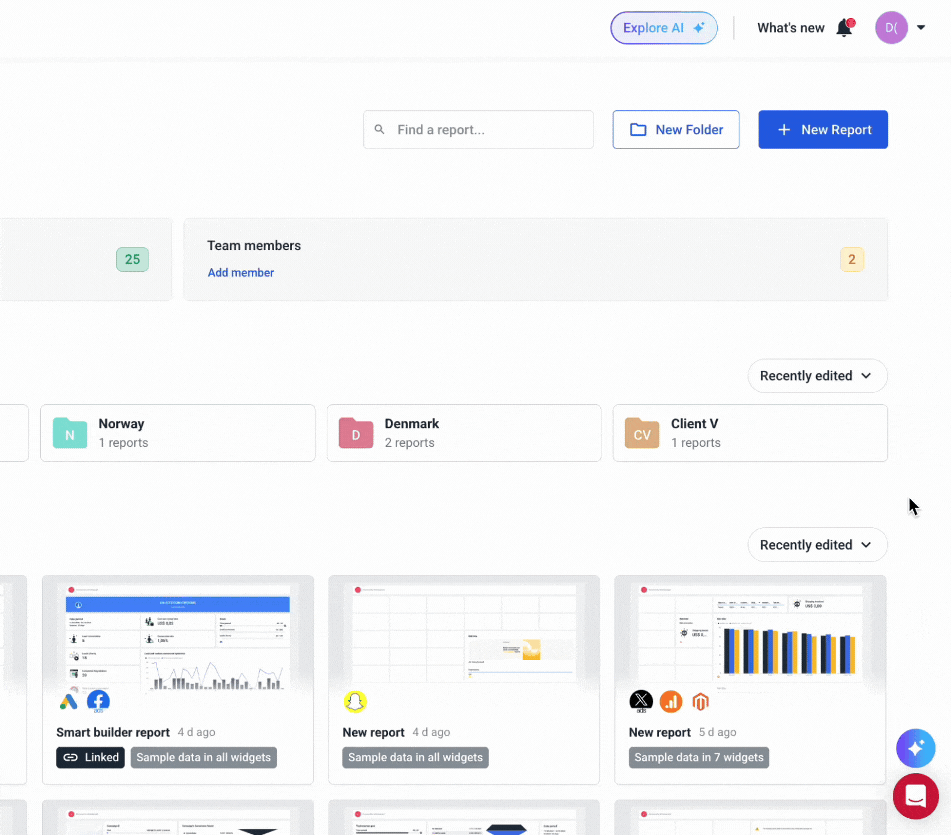
Now comes my favorite part. To style your social media report, simply upload a screenshot of the color scheme you want to use, or type in a custom prompt.
Whatagraph automatically detects the colors and fonts in the image and applies it to your report instantly.
Fine-tune the colors and fonts as needed and once you’re satisfied, save it as a “Global theme” to reuse it the next time.
It’s literally so easy, it’s mindblowing.

Managing naming conventions across platforms is usually a coding task. Not with IQ Dimensions!
Normalize and categorize messy data fields using natural language prompts, instantly making your data clean and consistent for analysis without any manual effort or code.
For example, if your Meta campaigns include inconsistent naming (‘Brand Awareness | IG’ vs. ‘IG_Brand_Awareness’), IQ Dimensions instantly groups them under one clean label.

All of these means you can:
✅ Easily create complete social media reports without needing any technical expertise
✅ Save hours on report creation
✅ Have more time and energy to focus on more important tasks
Can I easily tailor dashboards for each client or goal?
Absolutely. Whatagraph goes beyond surface-level KPI tracking to help you build a narrative that matches each client’s or campaign’s social goals—complete with audience insights, engagement trends, and conversion context.
Plus, in Spaces, every team or client gets their own dedicated environment—with custom dashboards, permissions, and data sources organized in one place.
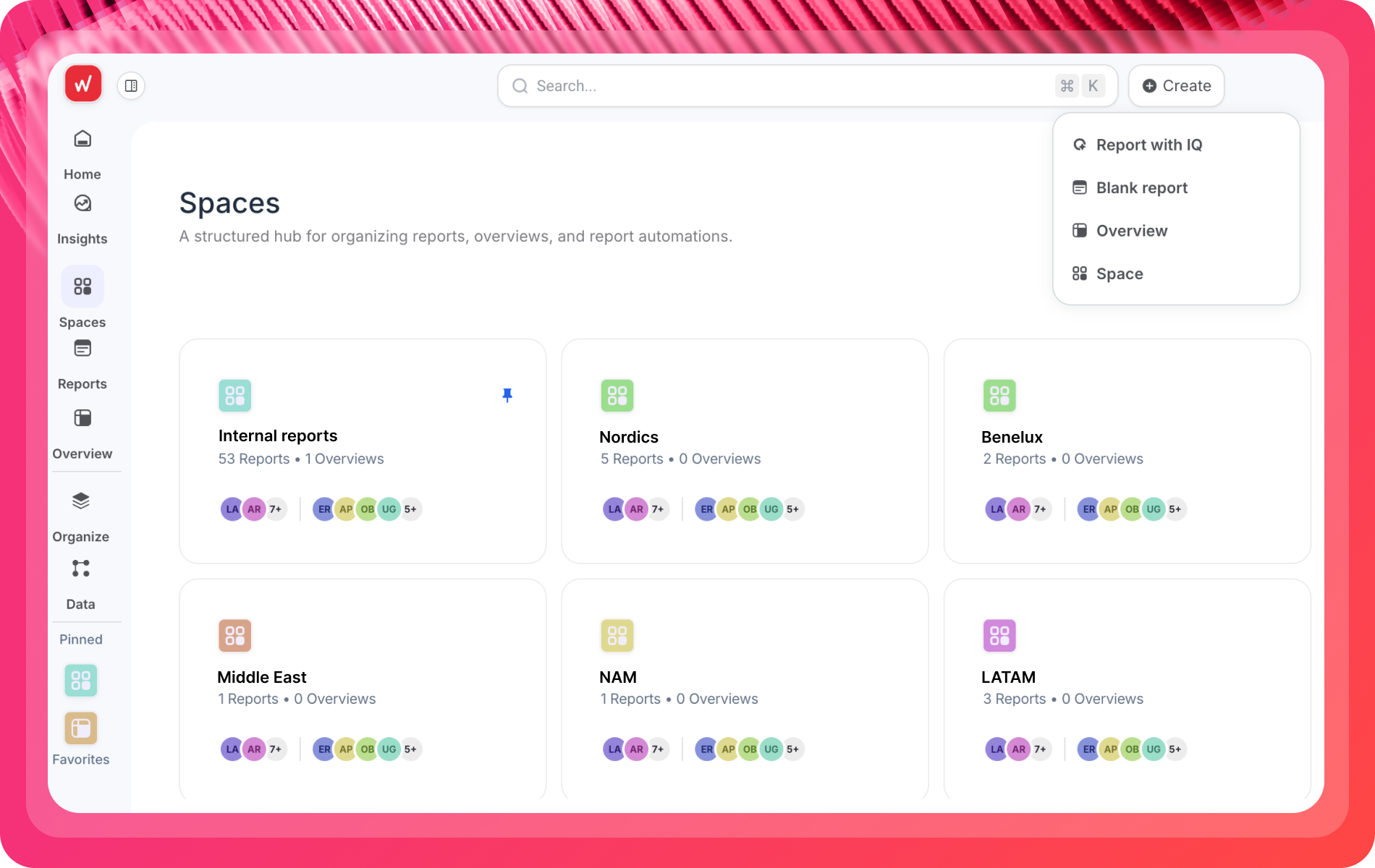
Start from a ready-made foundation like the Social Media Report Template that’s preloaded with audience insights, demographics, and engagement metrics: everything you need to analyze who’s engaging, where they’re from, and how your content performs across formats.
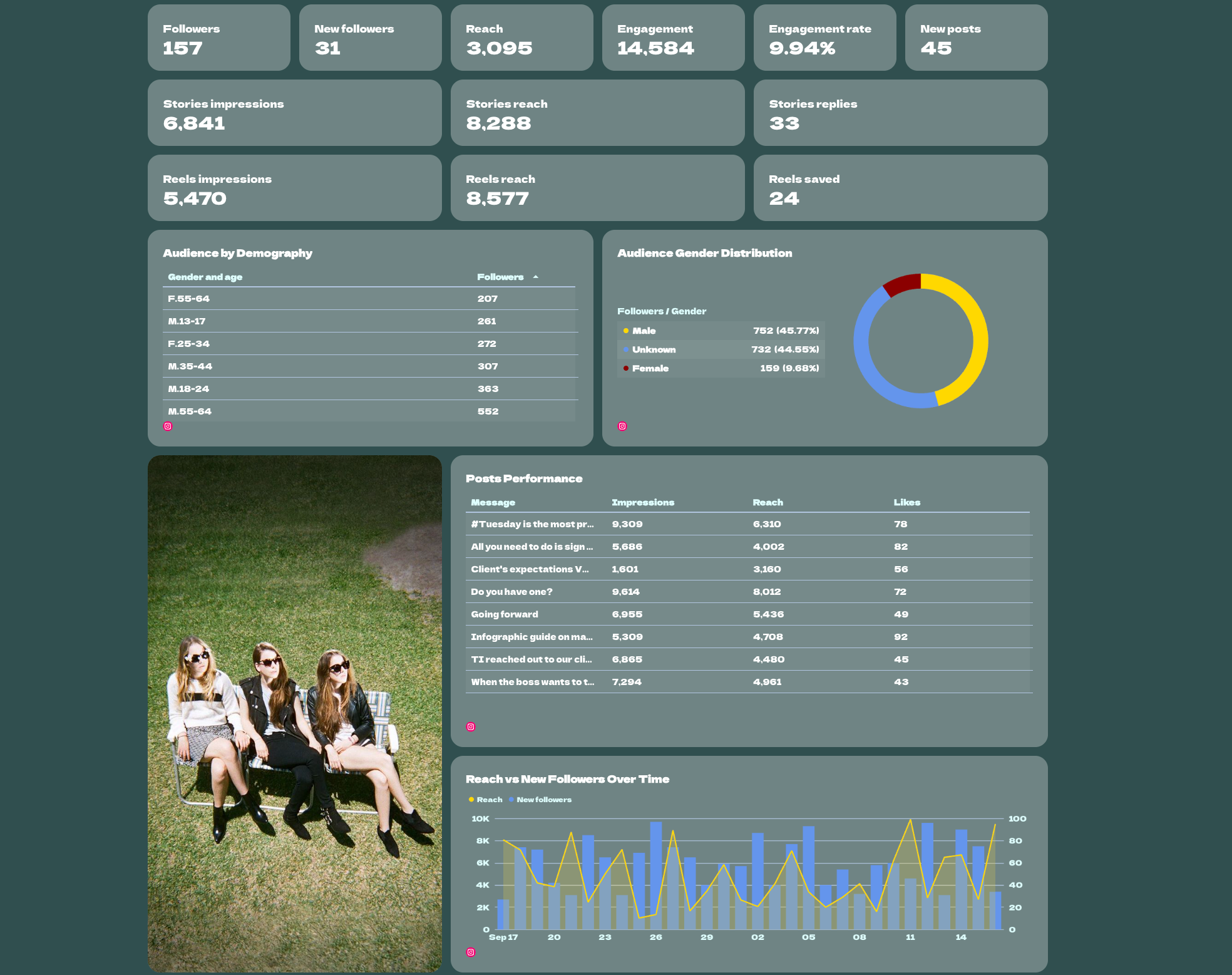
From there, you can:
- Tailor dashboards per client or campaign: Add or remove widgets, reorder sections, or focus on specific funnel stages (awareness, engagement, or conversions).
- Apply your brand in one click with IQ Theme: Upload a logo or enter a simple prompt (e.g., “dark theme with coral accents”), and IQ automatically styles every chart, tile, and text field to match your visual identity.
- Add instant AI-generated summaries with Whatagraph IQ: Generate quick “Wins” and “Issues” summaries right under your visuals to give stakeholders context alongside the data.
In Insights, powered by Whatagraph IQ, Whatagraph automatically surfaces performance highlights, anomalies, and actionable recommendations across all your Spaces. You don’t need to hunt through metrics: the platform tells you what changed, why it matters, and what to do next.
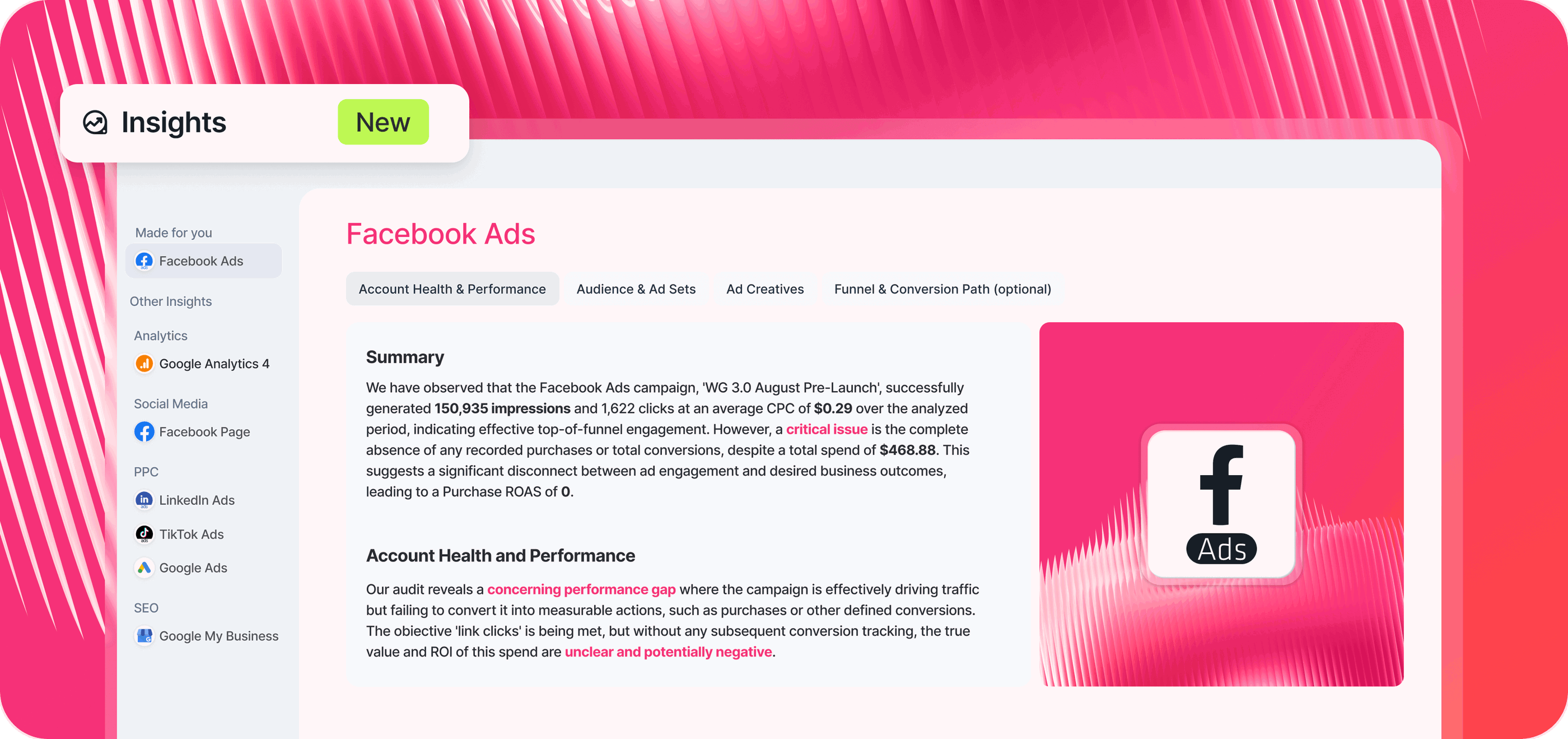
Bonus: Here are some micro-prompts you can use (copy/paste):
- Create report with IQ: “Build a monthly social media report for Brand A, compare to last month. Show organic vs paid performance, top content, and recommended next steps.”
- IQ Theme: “Create a clean light theme with charcoal text and a bold accent pulled from the uploaded logo.”
- IQ Dimensions (post type): “Group post types as Video, Carousel, Static, Story, Reel across Meta, Instagram, TikTok, LinkedIn, YouTube.”
Can I automate delivery so stakeholders get fresh data without lifting a finger?
Automation is baked into Whatagraph, so you never have to chase screenshots or manually update slides again.
- Schedule automatic deliveries: Set up reports to be automatically generated and delivered to any recipient's email on a daily, weekly, or monthly schedule, eliminating manual send-outs.
- Use custom domains to truly own your reports: The standard live report link (e.g., live.whatagraph.com/shared/...) is replaced with your own custom URL, such as: reports.agencyname.com/shared/. This feature also allows you to customize the sender email address for all automated reports. Instead of reports being sent from a generic email (like “reports@reports.live”), they come from your branded address, such as: “reports@agencyname.com.”
- Export reports in multiple formats: Share reports as a password-protected live link (with real-time data), or export as a PDF, CSV, or XLSX file to meet executive or client preferences.
- When sharing a live link, enable the client-facing IQ Chat feature: This allows your clients to ask questions about the data directly in the report interface, reducing back-and-forth communication with your team.
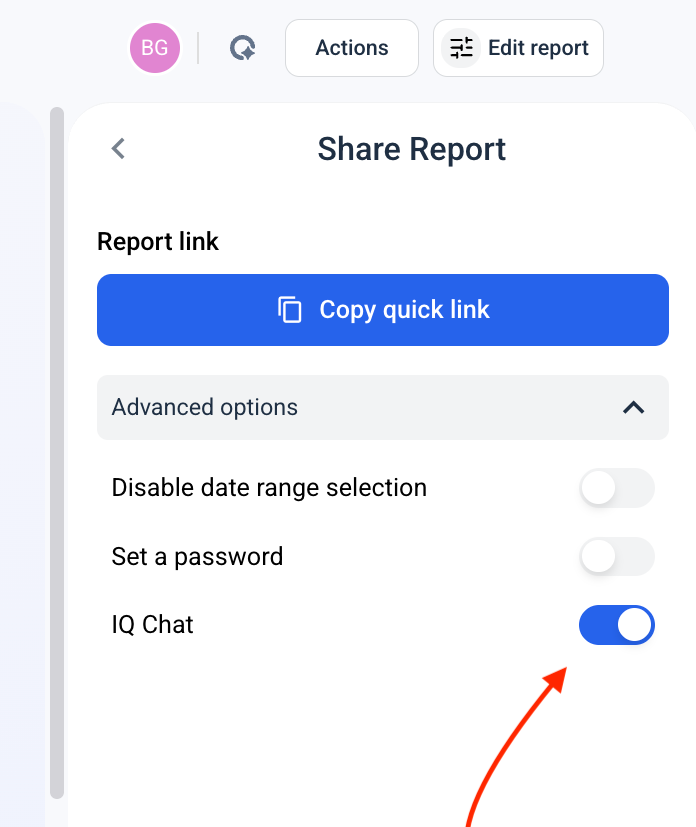
Key features:
- 55+ stable native integrations
- No-code custom data connection
- Organize data without coding (IQ Dimensions)
- True cross-channel data blending
- No-code data push to BigQuery
- AI report builder (IQ Report)
- AI-generated insights (IQ Summaries)
- Chat with data (IQ Chat)
- Library of pre-made templates
- AI-powered custom branding (IQ Theme)
- Full white-label and custom domain
- Intuitive drag-and-drop builder
- Centralized performance overview
- Bulk report editing
- Automated report scheduling
- Flexible export options (PDF, PPT, CSV)
- Client-facing IQ Chat
Pros:
- Built for marketers, not data scientists
- Reliable, human-led live chat support
- Real-time, automated dashboards
- All-in-one marketing analytics platform
- Lightning-fast insights with AI
Cons:
- Report load speed depends on data volume
- Learning curve for data blending
Pricing
Whatagraph uses tiered pricing based on the number of Source Credits (each connected account counts as one credit).
- Free at €0/month: 5Essential integrations, basic visualizations, Whatagraph IQ.
- Start at €199/month: 20Professional automation, branding, live chat support.
- Boost at €499/month: 60Advanced integrations, custom metrics/dimensions, full white-labeling, dedicated support.
- Max (custom pricing): 100+Premium integrations, custom data aggregations, Whatagraph IQ+, Single Sign-On (SSO).
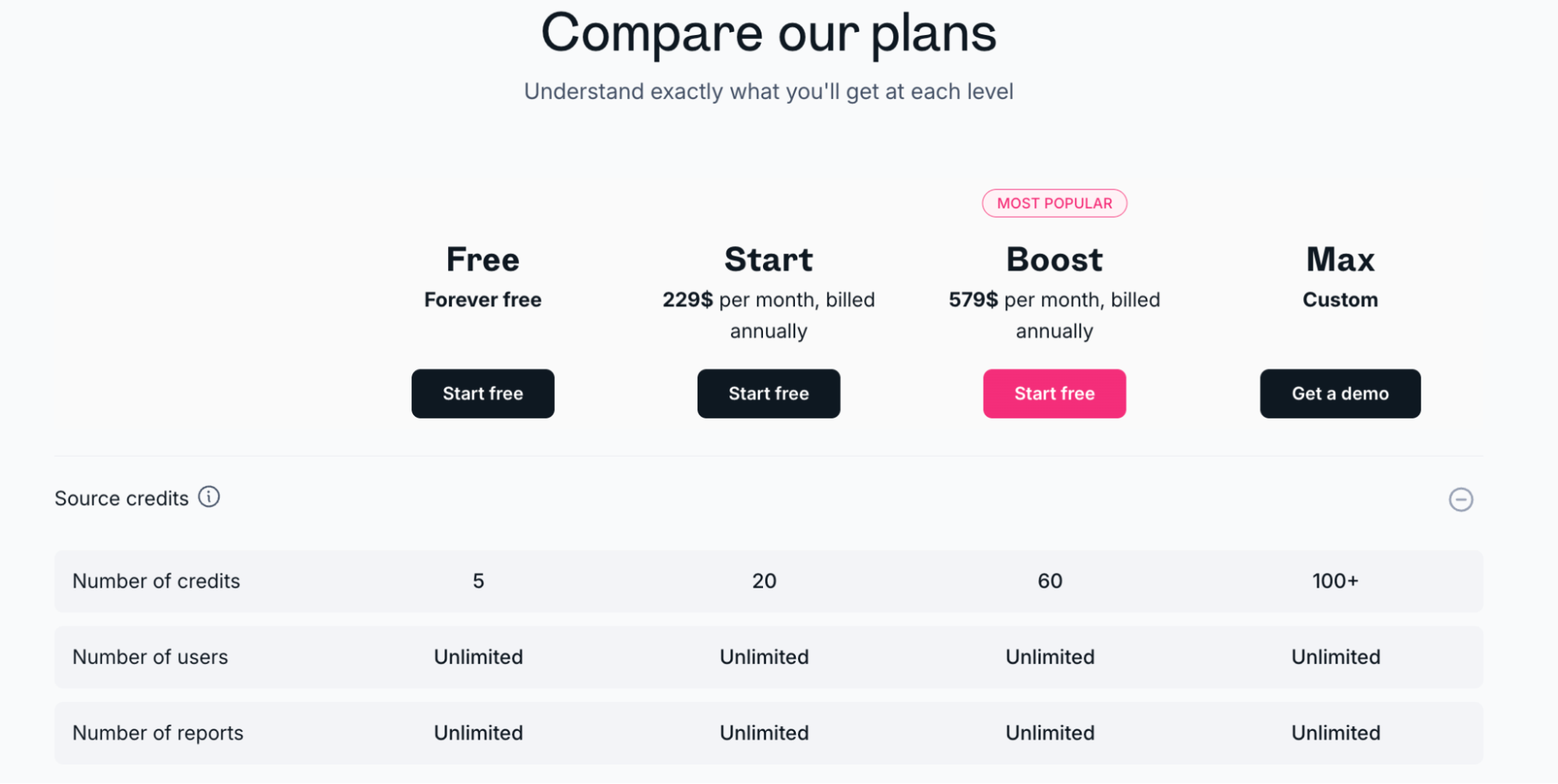
Whatagraph ratings:
- G2 rating: 4.5/5
- Capterra rating: 4.4/5
Start free: Build your first automated report with Whatagraph in minutes.
2. Metrics Watch
Metrics Watch is a social media data analysis tool that you can use to send reports directly to your team’s or clients’ inboxes.
The tool comes with a drag-and-drop builder that lets you easily create custom reports with data from all your marketing channels.
This means you can display key metrics from social media alongside Google Analytics insights or performance metrics from your paid ads accounts.
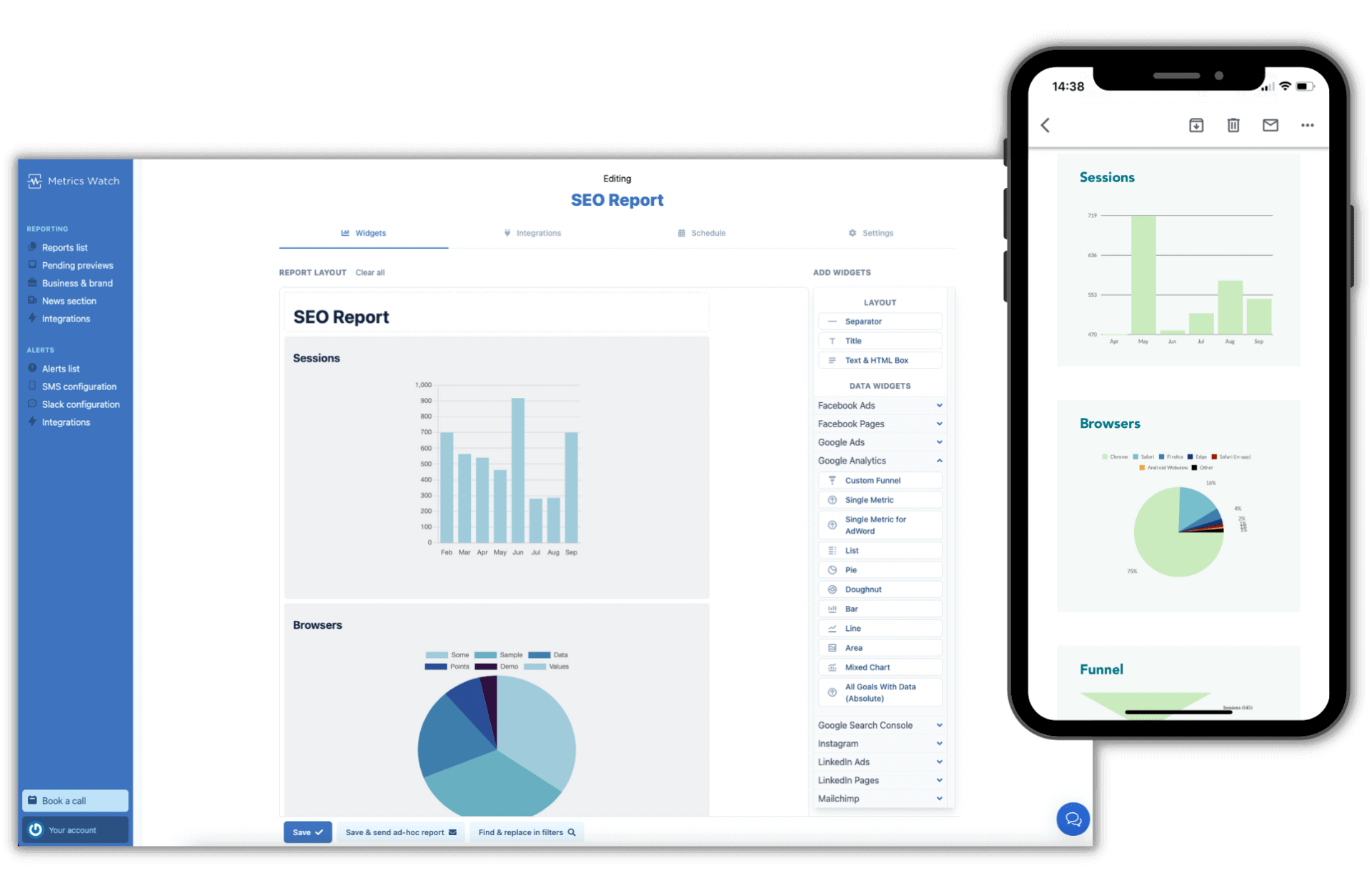
Instead of using PDF documents or building live dashboards, Metrics Watch has an email workflow where the clients or stakeholders get all the data in a custom email body with their logo and branding. This way, they can access their latest report from anywhere at any time.
Key features:
- Drag-and-drop visualization builder
- Pre-made report templates
- White-label reports
- Automated delivery
- Real-time alerts
Pros:
- Easy to set up
- Convenient report sharing in email body
- Automated delivery process
- Good support
Cons:
- Need help from customer support to set custom metrics
- Limited design options
- No blended metrics
- No real-time dashboards
Pricing
Here is a breakdown of Metrics Watch pricing as of October 2025:
| Plan | Price (Monthly) | Reports Limit | Data Sources | White Label | Free Migration | Advanced Widgets | Trial Period | Notes |
| Startup | $29 | Up to 2 reports | Unlimited | No | No | No | 14 days | Ideal for solo marketers or small teams |
| Pro (Most Popular) | $100 | Up to 25 reports | Unlimited | Yes | Yes | No | 14 days | Designed for growing businesses needing branded reports |
| Agency | $300 | Up to 100 reports | Unlimited | Yes | Yes | Yes | 14 days | Best for agencies managing multiple clients and accounts |
Notes:
- Pricing is in USD.
- Each “report” counts by configuration, not delivery frequency — you can schedule daily, weekly, or monthly sends at no extra charge.
- Larger or custom plans are available upon request.
Metrics Watch ratings and reviews
- G2: Rating: 4.5 · 2 reviews
- Capterra: Rating: 4.3 · 3 reviews
3. Keyhole
Keyhole is a real-time social media management tool with above average social analytics functionalities.
This tool offers analytics for Facebook, Instagram, X, YouTube, LinkedIn, and TikTok, aiming to help brands analyze all aspects of their online presence.
From influencer tracking to competitor analyses and campaign tracking to hashtag analytics, Keyhole monitors what followers say about your brand, tracks competitor behavior, finds leading social media influencers, spots upcoming trends and more.
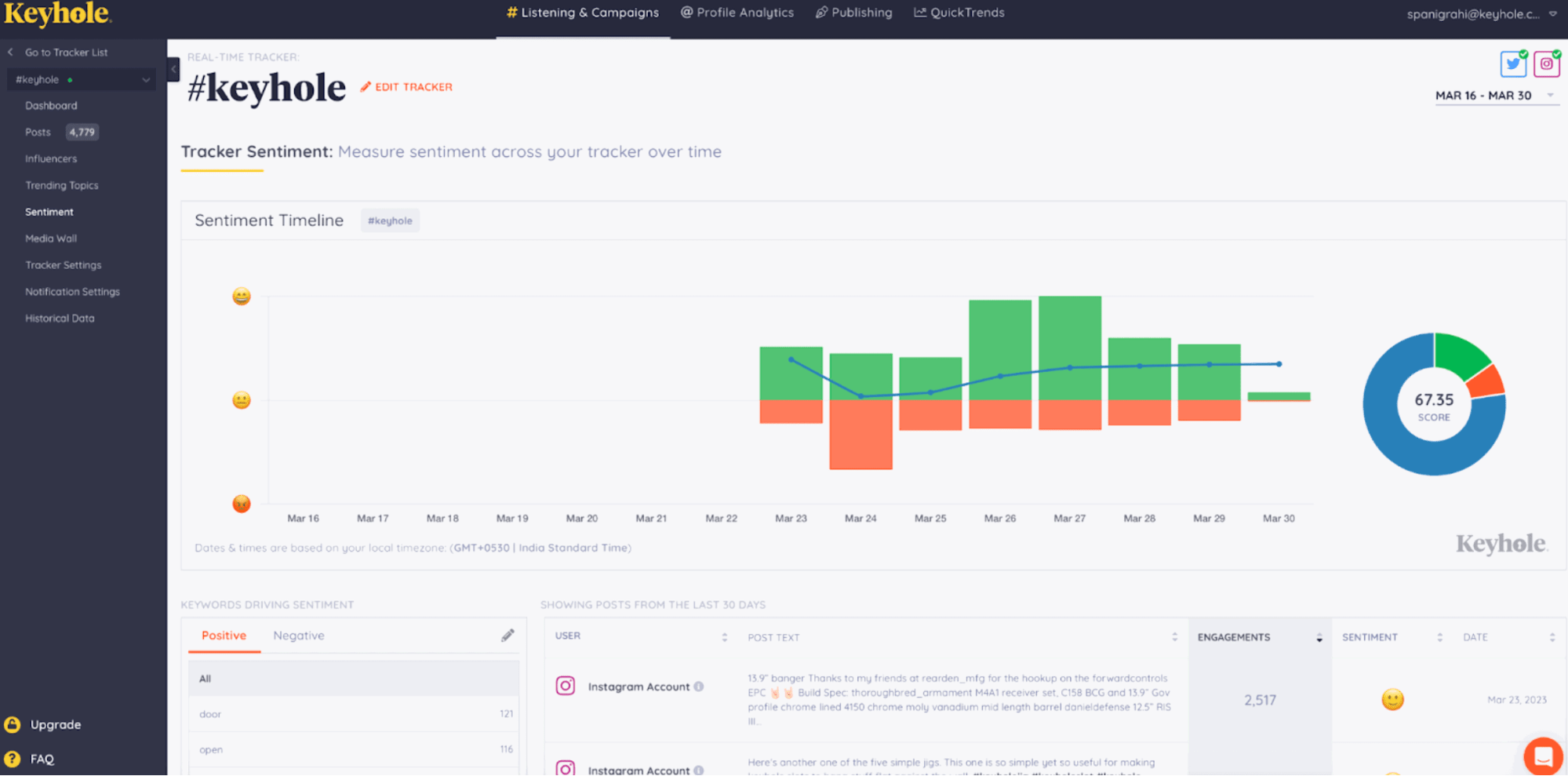
For example, you can use it to identify the best influences using detailed profile analytics, so you can be sure they are a good match for your brand. Keyhole can also help you find any red flags such as fake followers or negative sentiment.
Key features:
- Brand mentions
- Hashtag tracking & analysis
- Social listening
- Competitor analysis
- Influencer marketing
Pros:
- Monitoring reach and engagement via hashtags across social platforms
- Influencer profiling and performance analytics
- Reports are comprehensive and easy-to-understand
Cons:
- Steep learning curve
- Limited number of integrations
- Even the basic pricing plan might be too expensive for small businesses
Pricing
Here’s a breakdown of Keyhole’s pricing as of October 2025:
| Plan | Description | Best For | Core Features | Price (Monthly) | Notes |
| Basic (Essentials) | All the essentials for small brands to create social media reports easily. | Small brands and startups | Social media insights, performance tracking, shareable reports. | Starts at $89/month | Ideal entry plan for small teams. |
| Professional (Recommended) | Built for global organizations and agencies to measure performance, benchmark against competitors, and create shareable reports. | Mid-size to enterprise-level marketing teams & agencies | Competitor benchmarking, advanced analytics, multiple users, branded reports. | Custom quote on request | Recommended for agencies managing multiple clients. |
| Enterprise | Comprehensive analytics suite for global organizations. | Large corporations needing deep media intelligence | Full API access, unlimited reports, cross-platform integrations, enterprise support. | Custom pricing | Designed for organizations at scale. |
Notes:
- Keyhole typically offers a free trial upon request.
- Pricing is in USD and may vary depending on features selected.
- The Professional plan is labeled “Recommended” on the official site.
Keyhole ratings and reviews
- G2: Rating: 4.3 · 69 reviews
- Capterra: Rating: 5 · 2 reviews
4. Google Analytics 4
Google Analytics 4 is probably not your first idea of a social media analytics tool.
However, it’s a reliable way of tracking social media initiatives driving traffic to your website and can even help you measure social ROI.
In addition to a GA4 account to monitor your website traffic, you can create reports specifically for social media data tracking. For example, you can monitor how much traffic comes to your website from each social network or track specific social media campaigns with UTM parameters.

Although Google Analytics 4 is not going to be your all-in-one social media analytics tool, if you work for a web-based business, it can tell you which social media platforms send you the most traffic, what content drives the most leads, and what is the demographics of your audience.
Key features:
- Event-driven data model
- User-centric insights
- Cross-platform tracking
- Advanced funnel analysis
- Exploration reports
Pros:
- Real-time insights
- Predictive metrics
- Built-in privacy controls
- User ID tracking
- Life cycle insights
Cons:
- Steep learning curve
- Limited choice of built-in reports
- Difficult to integrate with non-Google platforms
- Tracking specific social media interactions requires manual setup
- GA4 is still evolving some features that were readily available in Universal Analytics
Pricing
Google Analytics 4 is free if you use the free version. A paid plan called Google Analytics 360 includes advanced analytics features, such as attribution modeling and data integration.
Google Analytics 4 ratings and reviews
- G2: Rating: 4.5 · 6,385 reviews
- Capterra: Rating: 4.7 · 8,073 reviews
5. Sprout Social
Sprout Social is an all-in-one social media management tool that helps brands create, schedule, manage, and monitor their social media content.
You can use Sprout Social to monitor key metrics from almost any social network — track Facebook impressions, aggregate X link clicks, measure Instagram follower growth, assess Linkedin engagement rate, evaluate content performance on Pinterest, and more from the same location.
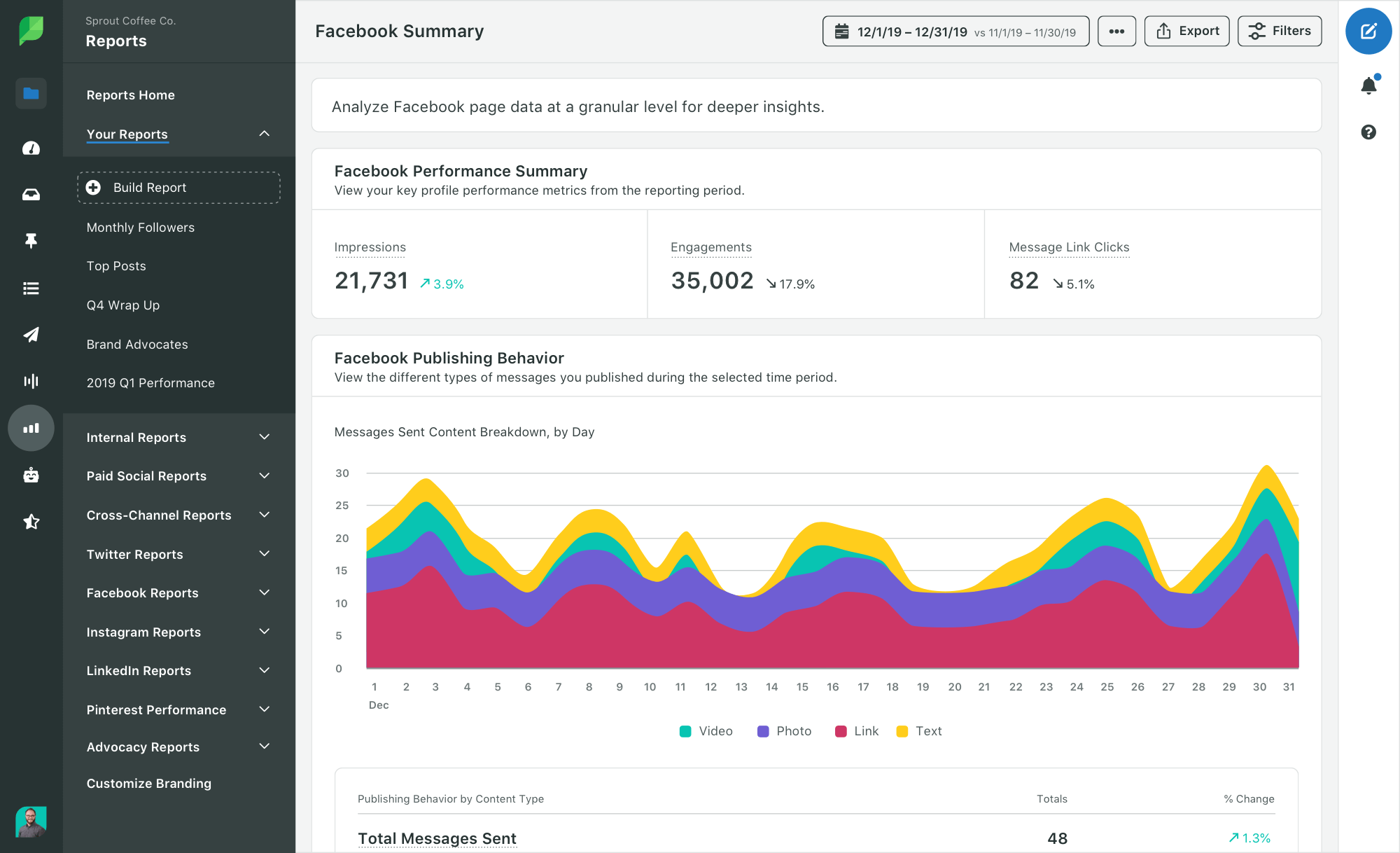
This social media analytics solution allows you to easily organize and share your data using intuitive presentation-ready reports. If you go for Premium Analytics, you can create custom reports tailored to your organization’s or clients’ specifics.
Key features:
- Engaging, easy to read graphs
- Sentiment analysis
- Competitor reports
- Option to tag content by campaign
- Boolean keyword searches
Pros:
- Content scheduling options
- Social listening
- Respond to DMs directly
Cons:
- Not very responsive support
- No Shopify integration
- Bugs with new Instagram API
Pricing
Here’s a breakdown of SproutSocial’s pricing as of October 2025:
| Plan | Price (Monthly, per seat) | Best For | Social Profiles | Key Features | Add‑ons Available |
| Standard | $199 | Small teams managing a few profiles | 5 | Keyword and location monitoring, unlimited AI‑generated alt text, review management, group/profile/post‑level reporting | Premium Analytics, Listening, Employee Advocacy, Professional Services |
| Professional (Most Popular) | $299 | Teams managing many profiles with high engagement | Unlimited | Everything in Standard, plus: message tagging, competitor/tag/paid insights, optimal send times, Enhance Post by AI Assist | Premium Analytics, Listening, Employee Advocacy, Professional Services |
| Advanced | $399 | Cross‑functional teams and workflows | Unlimited | Everything in Professional, plus: Enhance Reply by AI Assist, sentiment tracking in inbox/reviews, API & helpdesk integrations, team productivity reports, Message Spike Alerts | Premium Analytics, Listening, Employee Advocacy, Professional Services |
| Enterprise | Custom | Large‑scale organizations | Custom | Everything in Advanced, plus: white‑glove onboarding, dedicated SSO setup support, tailored enterprise plan, priority customer support | Premium Analytics, Listening, Employee Advocacy, Professional Services |
Add-ons Overview
- Premium Analytics: Advanced filtering, ROI proofing with charts, benchmarking, and shareable reports.
- Listening: AI‑driven topic identification, sentiment tracking, and spike alerts for real‑time insights.
- Employee Advocacy: Curated on‑brand content sharing, UTM tracking, and team discovery tools.
- Professional Services: Strategy consultations, training, dashboard design, and implementation support.
Sprout Social offers a 30‑day free trial (no credit card required) with annual billing in USD.
Sprout Social ratings and reviews
- G2: Rating: 4.4 · 3,370 reviews
- Capterra: Rating: 4.4 · 579 reviews
6. Buffer
Buffer is a versatile analytic tool for social media that comes with several features for analyzing and optimizing social media accounts.
Unlike most tools on this list, it doesn't offer analytics for all social media platforms. It also lacks social listening, paid content tracking, and competitive benchmarking features.
However, Buffer has a couple of report features that social media managers love. First, it consolidates all your data in one dashboard — perfect for busy teams who need a quick way to get up to date with the latest social media developments.
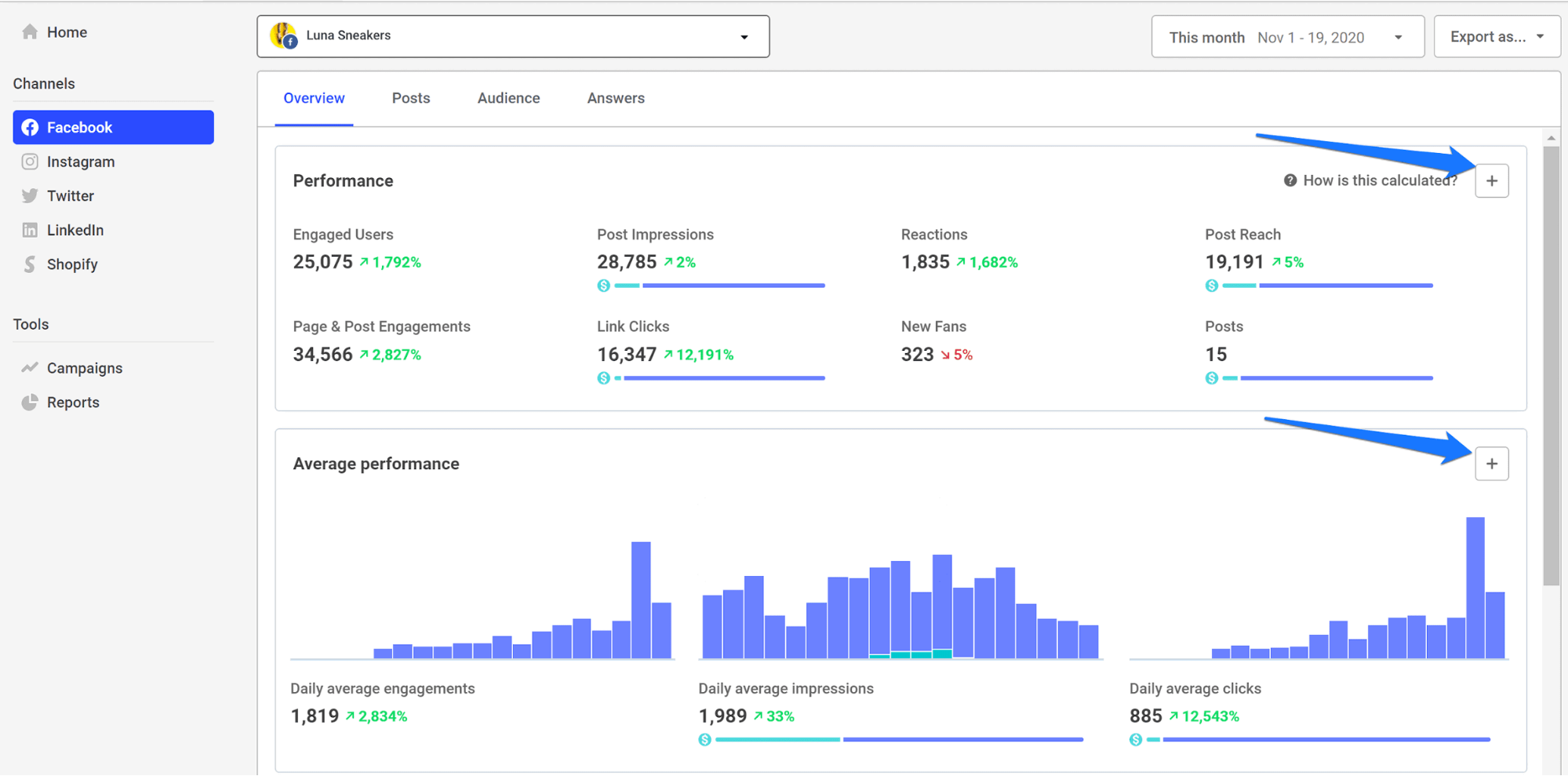
Buffer can also make recommendations based on content performance. With this tool, there’s no second guessing what the best time to post on LinkedIn is or what content to use on which platform. Buffer does the math and answers these questions instead of you to give you the best chances to grow.
Key features:
- Content planning and scheduling
- Content optimization
- Workflow management
Pros:
- AI-generated captions
- Scheduling tools
- Content calendar
- Simple analytics
Cons:
- Needs more integrations to social media platforms
- Carousel posts on Instagram are not supported
- The tool might be to basic for some users
Pricing
Here’s a breakdown of Buffer’s pricing as of October 2025:
| Plan | Price (Monthly) | Channels | Users | Key Features | Analytics | Collaboration & Access | Support | Free Trial |
| Free | Free forever | Up to 3 | 1 | 10 scheduled posts per channel, AI Assistant, 100 content ideas, basic analytics, browser extension, Start Page, integrations (Canva, Unsplash, Dropbox, etc.) | 30‑day analytics history | Notes, 2FA, no approval workflows | Email & knowledge base | None |
| Essentials (Recommended) | $5/month per channel ($60/year, save 2 months) | 1+ | 1 | Unlimited scheduled posts and ideas, AI Assistant, engagement inbox, hashtag manager, first comment scheduling, advanced analytics | Unlimited | Notes, 2FA, no approval workflows | Email & knowledge base | 14‑day free trial |
| Team | $10/month per channel ($120/year, save 2 months) | 1+ | Unlimited | All Essentials features plus approval workflows, access levels, content permissions, branded reports | Unlimited | Full team collaboration, approval control | Email & knowledge base | 14‑day free trial |
Quick highlights:
- All plans include access to integrations like Canva, Unsplash, Dropbox, Google Drive, Zapier, IFTTT, and WordPress.
- Paid plans allow unlimited scheduled posts (up to 5000 per channel under fair use policy).
- Nonprofits and charities receive a 50% discount.
- Billing is monthly or annual, with a 20% discount for annual payments.
- Both Essentials and Team plans include AI Assistant for post optimization.
Buffer ratings and reviews
- G2: Rating: 4.3 · 1,005 review
- Capterra: Rating: 4.5 · 1,477 reviews
7. Hootsuite
Hootsuite is a social media analytics platform that allows marketers to plan, schedule, and syndicate social media posts across multiple networks from one place.
This social media tool offers automatic scheduling, social media monitoring, performance analytics, and basic task management on channels like Facebook, Instagram, TikTok, YouTube, Pinterest, and others.
Using the Stream feature, marketers can monitor mentions, hashtags, and keywords from specific social media accounts.
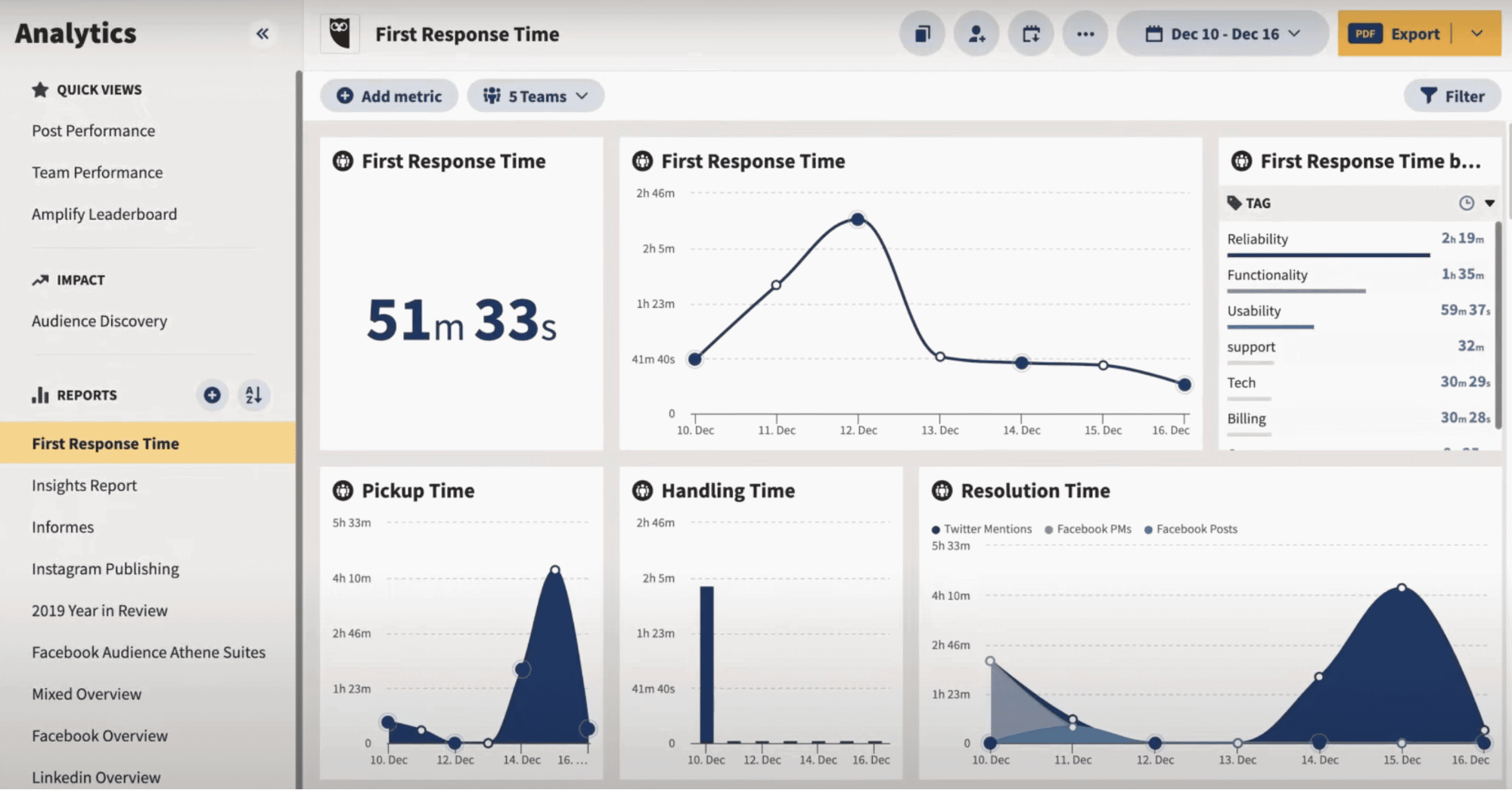
The Hootsuite Analytics feature offers in-depth performance insights and includes key metrics such as posts and tweets, engagement, traffic, fans and followers, and more. You can use it to schedule reports for automatic sending via email on a weekly or monthly basis.
Key features:
- Boolean keyword searches
- Filtering out noise and spam
- Sentiment analysis
- Content planning and scheduling
- Automated routing and prioritization
- Customer interaction histories
- Lead generation
Pros:
- Multi profile scheduling
- Unlimited posts with all plans
- Schedule and publish directly from Hootsuite
- Post time optimization
- Includes stock photos
- Integrates with Canva
- Built-in Grammarly
Cons:
- No longer offers a free plan
- Free trial requires a credit card
- Support is slow to reply
- No integration for Google Business Profile
Pricing
Here’s a breakdown of Hootsuite’s pricing as of October 2025:
| Plan | Price (Monthly, billed annually) | Social Accounts | Users | Best For | Key Features | Analytics | Support | Free Trial |
| Standard | per user/month (exact price depends on currency) | 10 | 1+ | Small teams or solo marketers | Unlimited scheduling, AI text generation (OwlyWriter + OwlyGPT), Canva integration, media library, link shortener (Ow.ly & Bitly), bulk scheduling (350 posts), visual content calendar | Core analytics, compare performance across networks, track up to 5 competitors | Email support, help center | 30‑day free trial |
| Advanced (Most Popular) | per user/month (exact price depends on currency) | Unlimited | 1+ | Agencies or larger businesses managing multiple clients | Everything in Standard plus enhanced AI tools, team collaboration, approval workflows, ROI tracking, custom branded reports, competitor analysis (up to 20), audience optimization by network | Advanced analytics, exportable reports (.PDF, .PPT, .CSV), automated report scheduling | Priority support | 30‑day free trial |
| Enterprise | Custom pricing | Unlimited | 5+ | Large organizations with complex teams | Everything in Advanced plus employee advocacy, CRM integrations (Salesforce Service Cloud), AI chatbots, multi-language sentiment and listening data, compliance integrations | Full reporting suite, ROI and engagement dashboards, internal collaboration metrics | Dedicated onboarding, priority SLA support | Demo on request |
Additional plan details:
- All plans provide AI-assisted social publishing, bulk scheduling, and cross-network management.
- Competitor analytics and social listening scale up with plan tiers: 5 competitors (Standard), 20 (Advanced/Enterprise).
- Listening coverage expands to 150M+ data sources (Enterprise).
- Nonprofit discounts are available across select plans.
- Plans include a 30-day free trial, with a 10% discount for users who skip the trial and start annual billing directly.
Hootsuite ratings and reviews
- G2: Rating: 4.2 · 4,234 reviews
- Capterra: Rating: 4.4 · 3,699 reviews
8. Brandwatch
Brandwatch is a social media analytics software that is positioned as a customer intelligence tool with analytics capabilities.
It offers a suite of tools for analyzing your clients’ social media accounts and monitoring brand reputation and social share of voice.
Thanks to its Consumer Research feature, this social media analytics tracker pulls data from 1.4 million posts. It uses AI to filter out trends and segment the most relevant data to your or your client’s business.

Email alerts that notify you when sentiment or conversion changes in volume are also available. Social listening and competitive analysis can help you streamline the content creation, while audience profile cards can give you a better understanding of the audiences that engage with your social content.
Key features:
- Analyzes data from more than 100 million sources
- Customizable dashboards
- Audience profile cards
- Proprietary listening technology
- The most advanced, customizable charting and analysis functionality available
- Unlimited users
- 30+ fully-supported languages
Pros:
- Includes influencer management
- Responsive customer support
- Community management
- Reliable API connection
Cons:
- Reporting is very basic
- Not the best UI with larger categorization sets
- Limited historical data
- No way to save a dashboard as a template
Pricing
Brandwatch doesn’ have publicly listed pricing plans, so the pricing is available on request. To find out how much you need to pay, you need to request a demo and ask for a quote.
Brandwatch ratings and reviews
- G2: Rating: 4.4 · 606 reviews
- Capterra: Rating: 4.3 · 231 reviews
9. Rival IQ
Rival IQ is another social media analytics software that you can use to analyze and manage content on several different platforms, like X, Instagram, YouTube, LinkedIn, and TikTok.
As its name reveals, Rival IQ is designed to track competitors and present actionable insights on a simple yet customizable dashboard.
In addition, this social media analytics tool comes with a number of free tools for small businesses who want to monitor their social media analytics on a budget.
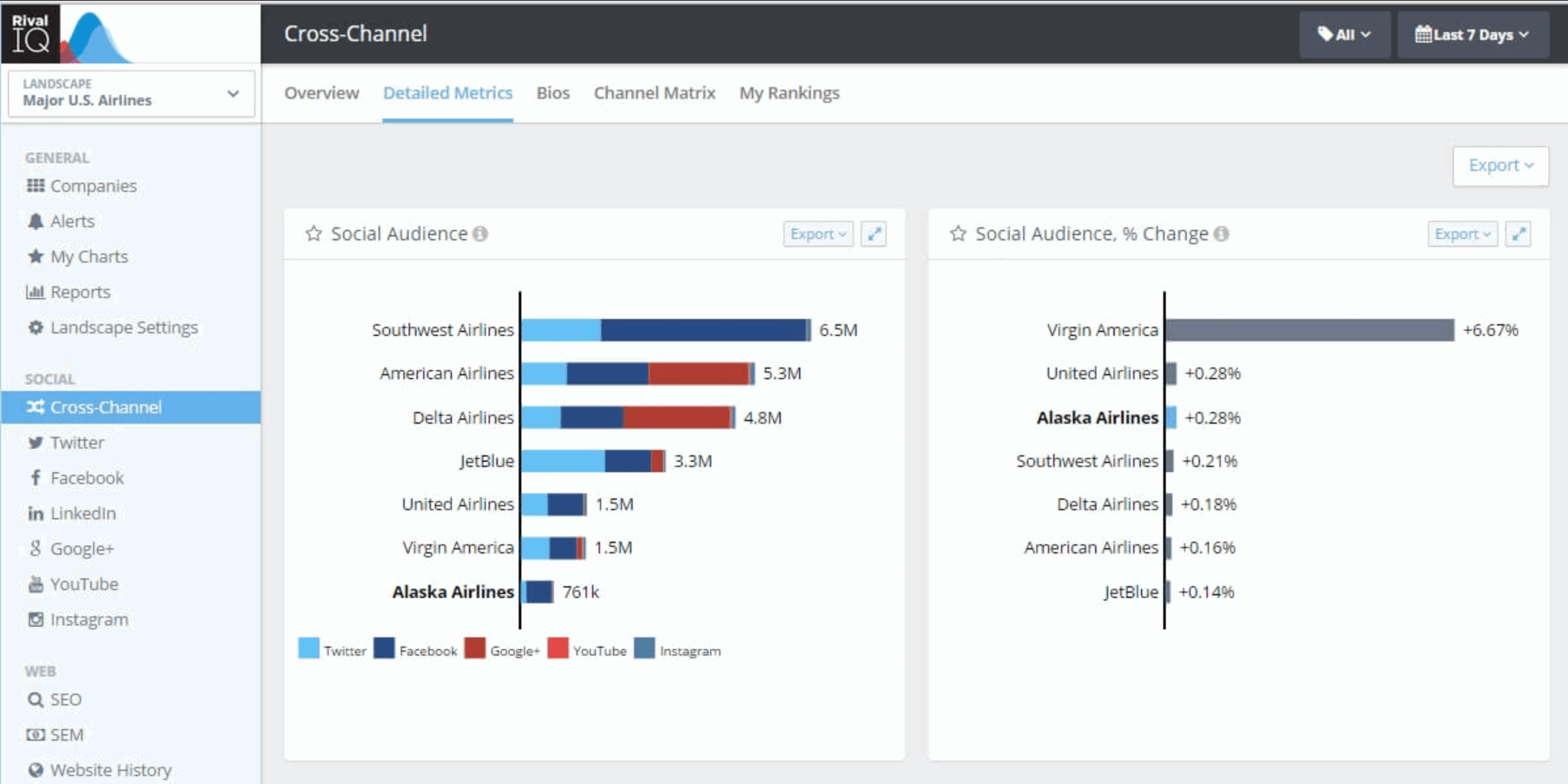
In its basic mode, Rival IQ gives you a neat presentation of the usual social media analytics metrics, such as follower growth, conversions, and other engagement metrics.
Key features:
- Competitive analysis
- All social media metrics in one place
- Competitive benchmarking
- Machine learning
Pros:
- Easy to visualize data
- Robust platform that improves continually
- Competitor insights
- Industry behavior reports
Cons:
- Limited collaboration in the basic plan
- Lack of customization options
- Expensive for small businesses
Pricing
Here’s a breakdown of Rival IQ’s pricing as of October 2025:
| Plan | Monthly Price | Tracked Companies | Data History | Users | Key Features | Add-ons / Integrations | Best For | Free Trial |
| Drive | $239/month | 10 | 6 months | 1 (add’l $10/user) | Competitive social metrics & benchmarking, social content analysis (hashtags, topics, timing), email alerts, scheduled updates | N/A | Solo marketers or small teams | 14‑day free trial |
| Engage | $349/month | 20 | 12 months | 2 (add’l $10/user) | Everything in Drive plus private data analysis (FB, IG, X, LinkedIn), Facebook Ads reporting, Google Data Studio connector, Instant Search | Facebook Ads accounts (5), Twitter Analytics accounts (5) | Mid‑size teams managing multiple brands | 14‑day free trial |
| Engage Pro | $559/month | 40 | 24 months | 5 (add’l $10/user) | Everything in Engage plus multi‑handle private data comparison, estimated impressions, API access (add‑on) | Facebook Ads accounts (10), Twitter Analytics accounts (10) | Agencies & advanced marketing teams | 14‑day free trial |
| Enterprise / Volume | Custom pricing | Custom | 24+ months | Custom | Tailored analytics, AI‑based impressions, advanced data integration options | Full API & large‑scale tracking tools | Enterprise analytics & global teams | Contact sales |
Common features:
- Competitive benchmarking and social post analysis
- Hashtag, topic, and content performance tracking
- Email alerts, scheduled exports, and branded reports
- Custom chart builder and date ranges
- Unlimited landscapes for client or segment grouping
Rival IQ ratings and reviews
- G2: Rating: 4.6 · 48 reviews
- Capterra: Rating: 4.4 · 13 reviews
10. Zoho Social
Zoho Social is a social media analytics platform that allows you to understand your social media audience and engagement. You can use it to listen to multiple channels from one dashboard and respond in real-time.
Designed for marketers from small to large organizations, Zoho Social helps them grow the social media presence of their brand.
Not only does it offer pre-publishing in sight based on the previous posts’ engagement level, but it also shows the percentage of the audience that’s likely to see your post now — suggests the best time to post and lets you schedule a post to go live at the same time of day in different time zones.
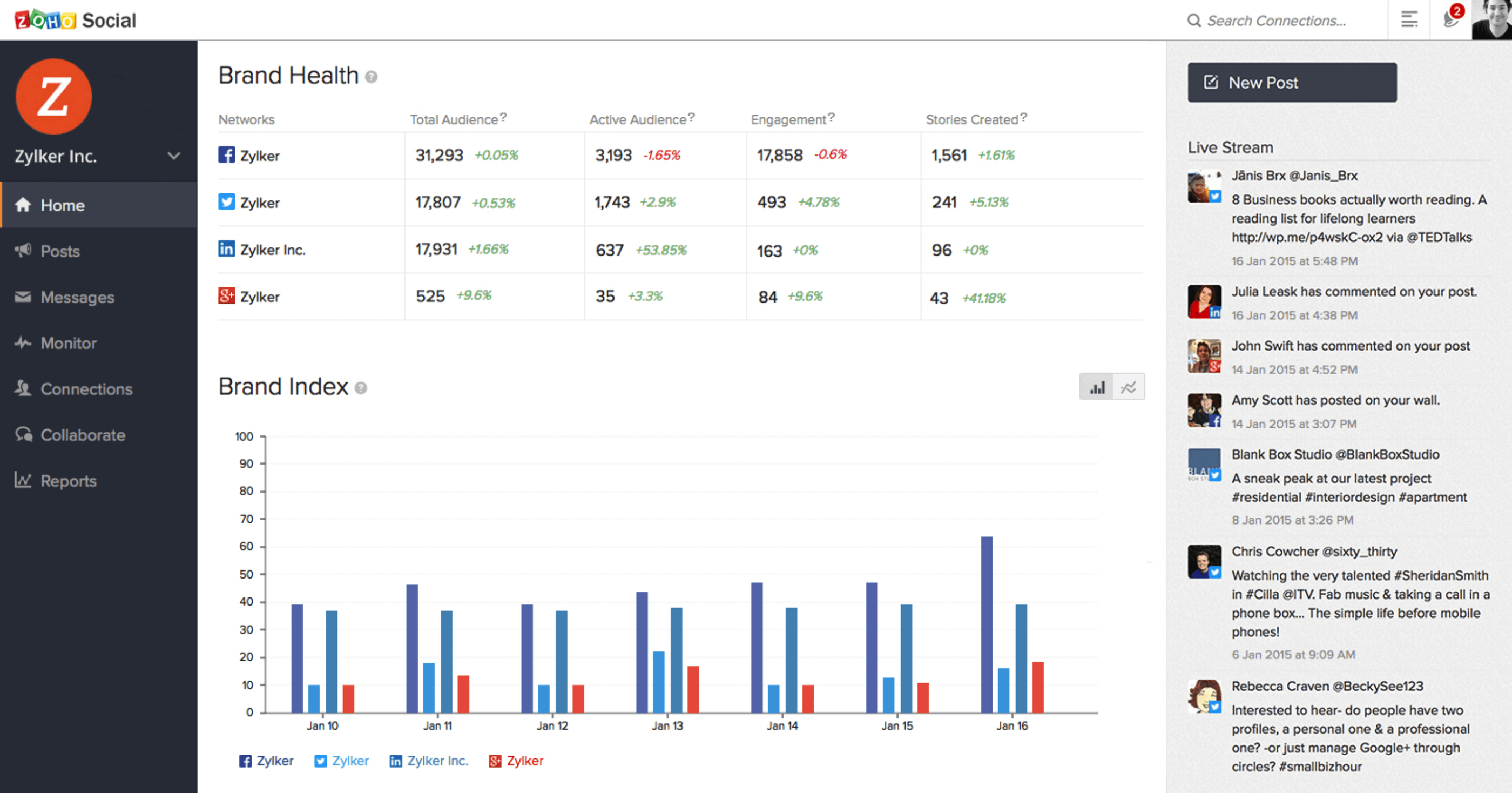
Using a dedicated reports tab, you can deliver social-network-specific statistics and detailed analytics to clients or stakeholders, helping them better understand their audience and how people engage with their content.
Key features:
- Breakdown of content formats the audience engages with and those you publish currently
- Fans vs. other people reach
- Pre-defined report segments
- Sentiment analysis
- Content planning and scheduling
- Automated routing and prioritization
Pros:
- Consolidated dashboard for all platforms
- Schedule multiple posts simultaneously
- Easy to customize reports
- Useful mobile app
Cons:
- No AI post-writing support
- Email support
- Doesn’t integrate with WhatsApp and Viber
- Limited in-depth analytics
- No way to analyze organic and paid content data separately
Pricing
Here’s a breakdown of Zoho Social’s pricing as of October 2025:
| Plan | Monthly Price (USD) | Brands / Channels | Team Members | Core Features | Integrations | Support | Free Trial |
| Free | Free forever | 1 Brand (6 channels: X, Instagram, Facebook, LinkedIn Page/Profile, Google Business) | 1 | Basic dashboard, scheduling, drafts, image editor, publishing calendar, zURL shortener | None | 24/5 email | 15‑day free trial |
| Standard | $15/month | 1 Brand (10–11 channels: adds Pinterest, TikTok, Mastodon, Threads, Bluesky) | 1 | All Free features + bulk scheduling, media library, analytics, post insights, Bitly shortener, RSS feeds | None | 24/5 email | 15‑day free trial |
| Professional | $40/month | 1 Brand (10–11 channels) | 1 | Standard + livestreaming, SmartQ, repeat posting, inbox, monitoring dashboard, post approvals | Zoho CRM, Zoho Desk | 24/5 email | 15‑day free trial |
| Premium | $65/month | 1 Brand (13–14 channels: adds YouTube, WhatsApp Business, Telegram) | 3 | Professional + team collaboration, custom reports, UTM tagging, content approvals, role management, CRM lead sync | Zoho CRM & Desk | 24/5 email | 15‑day free trial |
| Agency | $320/month | 10 Brands (130–140 total channels) | 5 | Premium + client portal, portal customization, branded reports, client logins | Zoho CRM & Desk | 24/5 email | 15‑day free trial |
| Agency Plus | $460/month | 20 Brands (260–280 total channels) | 5 | Agency + 10 additional brands, multi‑client management, extended channel capacity | Zoho CRM & Desk | 24/5 email | 15‑day free trial |
Key notes:
- Prices shown are for monthly billing, with 33% savings on annual billing.
- Add-ons available for extra brands and users (up to 5 additional on some plans).
- All paid plans include Zia (AI powered by ChatGPT) for generating social posts and replies.
- Nonprofits receive special discounted rates.
- Mobile access through Zoho Social apps for Android & iOS.
Zoho Social ratings and reviews
- G2: Rating: 4.6 · 2,608 reviews
- Capterra: Rating: 4.7 · 3,146 reviews
11. Mentionlytics
Mentionlytics is an all-in-one social media analytics tool that helps you understand how audiences feel about your brand, competitors, and industry.
This tool is a great place to start using social media analytics for brand monitoring, especially for businesses with global operations in different languages.
Mentionlytics tracks mentions across all web and social media sources, analyzes the data, and provides valuable insights about your or your client’s online performance.
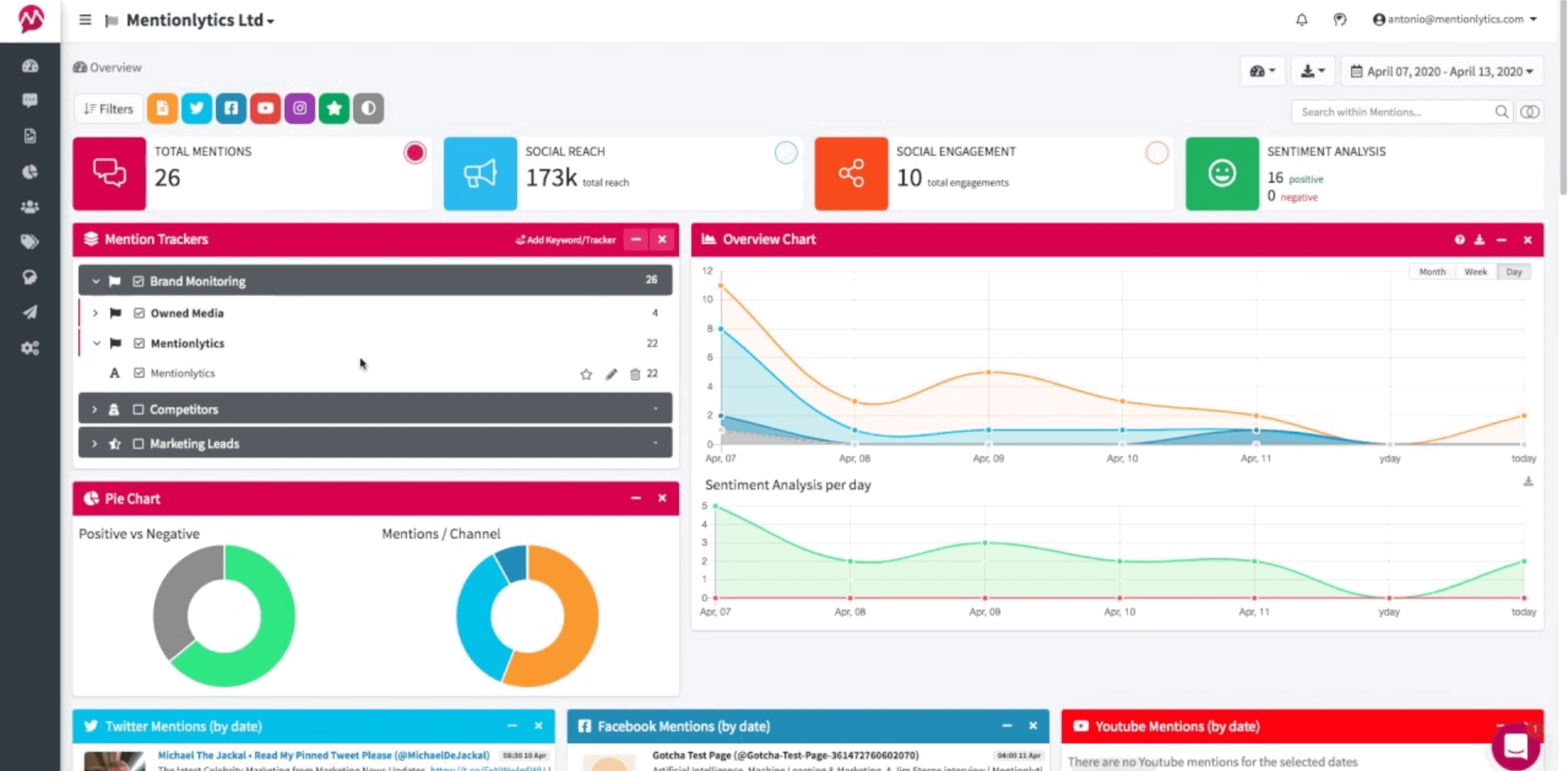
You can also use it to identify influencers and track relevant hashtags. Analyze keywords and engagement, and reach and aggregate the insights in performance reports to measure your success and benchmark against competitors.
Key features:
- Real-time alerts
- Share of voice reports
- Influencer identification
- Social intelligence advisor
- AI-powered emotion analysis
- Multi-language sentiment analytics
Pros:
- Time-saving scattered data consolidation
- Reasonably-tiered pricing structure
- User-friendly interface
Cons:
- Slow loading time
- Limited customization options
- Keyword monitoring can return irrelevant results
Pricing
Here’s a breakdown of Mentionlytics’ pricing as of October 2025:
| Plan | Monthly Price (USD, billed yearly) | Keyword Rules | Monthly Mentions | Update Frequency | Social Profiles | Users | Core Features | Reporting & AI |
| Basic | $49 (regularly $69) | 3 | 5,000 | Every 12 hours | 10 | 2 | Web + social monitoring, brand mentions, Boolean search, sentiment analysis | Standard reports, dashboard exports (PDF/Excel) |
| Essential | $169 | 10 | 15,000 | Every 6 hours | 20 | 10 | All Basic features + engagement analytics, competitor dashboards, AI sentiment | Enhanced analytics dashboards, competitor metrics |
| Advanced | $299 | 15 | 50,000 | Continuous | 30 | Unlimited | All Essential + custom dashboards, demographics, owned media analytics, AI emotion analysis | Standard reports + AI emotion analysis |
| Pro | $499 | 25 | 100,000 | Continuous | 40 | Unlimited | All Advanced + customizable & white-label reports, AI mention clustering, separate client accounts | Custom/white-label reports, AI mention clustering |
| Business | $749 | 40+ | 200,000+ | Continuous | 60+ | Unlimited | All Pro + white-label reports, client portal access, expanded monitoring | White-label, separate account management |
| Enterprise | From $999 | 100+ | Custom | Continuous | 100+ | Unlimited | Fully customizable configuration; tailored mentions, reports, and integrations | Custom dashboards, branding, and white-label options |
Additional details:
- All Pro plans and higher support AI Mention Clustering, AI Emotion Analysis, and White-Label Reports.
- All plans offer free trials.
- Managed Service Add-on: Mentionlytics experts manage monitoring, reports, and setup.
- Includes integrations with Slack, Hootsuite, Looker Studio, Power BI, and API access for automation.
- Billed annually (save 2 months); monthly billing also available.
Mentionlytics ratings and reviews
- G2: Rating: 4.4 · 606 reviews
- Capterra: Rating: 4.9 · 74 reviews
12. BuzzSumo
BuzzSumo is an influencer marketing platform that you can use to analyze the social engagement of any post or piece of content. It can help you find influencers and authors, analyze content to locate trends and compare domains and competitors.
Acquired by Brandwatch in 2017, BuzzSumo can let you track the performance of content competing for relevant industry keywords so you can see how your content marketing activities are performing in relation to the competition.

Thanks to the Content Analyzer feature, you are able to figure out what topics receive the most engagement by individual platforms.
Key features:
- Real-time trends overview
- Content Analyzer
- Keyword tool
Pros:
- Accurate social share counts
- Content research
- Backlink checking
- Slack alerts
- Excellent influencer database and search
Cons:
- Price much higher than other alternatives
- Content curation feature lacks refinement
- Interface and navigation could be improved
Pricing
Here’s a breakdown of Buzzsumo’s pricing as of October 2025:
| Plan | Monthly Price (Billed Yearly) | Core Features | Usage Limits | Journalist & Influencer Access | Data History | Reporting & API |
| Content Creation | $199/month (save $478/year) | Content discovery, keyword tracking, topic research, trend monitoring | 2k articles/month, unlimited searches | 20 journalists per list | 2 years | Standard reports, dashboard exports |
| PR & Comms | $299/month (save $718/year) | All Content Creation features + media monitoring, coverage tracking, outreach tools | 10k articles/month, unlimited searches | 100 journalists per list | 3 years | PR reports, coverage analytics |
| Suite(Most Popular) | $499/month (save $1198/year) | Everything in PR & Comms + team collaboration, expanded alerts & exports | Unlimited articles/searches | 600 journalists per list | 5 years | Full analytics suite, advanced exports |
| Enterprise | $999/month (annual billing only) | Everything in Suite + API access, unlimited projects, advanced integrations, custom dashboards | Unlimited | 1000+ journalists per list | 5+ years | Full API (Search + Account APIs), custom reporting |
Additional notes:
- Annual billing for Enterprise only; other plans can be billed monthly.
- All tiers include social monitoring, influencer discovery, keyword alerts, and engagement tracking.
- Integrations include Slack, Klips, Uberflip, and full API access for automation.
- Discounts available for nonprofits and educational institutions.
BuzzSumo ratings and reviews
- G2: Rating: 4.4 · 606 reviews
- Capterra: Rating: 4.3 · 231 reviews

WRITTEN BY
Brinda GulatiBrinda Gulati is a fractional content marketer and freelance writer who specializes in data-driven storytelling and writing easy-to-understand, informative content for humans. She has two degrees in Creative Writing from the University of Warwick, and believes that above all, stories are a deeply human endeavor. She has two dogs, knows thrifting spots, and loves afternoon naps.